THIS IS A WARNING!!!: THIS IS GONNA BE A LONG READ !!!
One of the longest-running, best-known and most comprehensive home flight simulator series, Microsoft Flight Simulator was an early product in the Microsoft portfolio – different from its other software which was largely business-oriented – and is its longest-running franchise, predating Windows by three years.
Bruce Artwick developed the Flight Simulator program beginning in 1977 and his company, subLOGIC sold it for various personal computers. In 1982 Artwick's company licensed to Microsoft a version of Flight Simulator for the IBM PC, which was marketed as Microsoft Flight Simulator 1.00. Microsoft CEO Bill Gates was fascinated with Antoine de Saint-Exupéry's "The Night Flight", which told in great detail of the sensations of flying a small aircraft.
Microsoft Flight Simulator began life as a set of articles on computer graphics written by Bruce Artwick in 1976 about a 3D computer graphics program. When the magazine editor said that subscribers wanted to buy the program, Bruce Artwick incorporated a company called subLOGIC Corporation in 1977 and began selling flight simulators for 8080 computers such as the Altair 8800 and IMSAI 8080. In 1979 subLOGIC released FS1 Flight Simulator for the Apple II. In 1980 subLOGIC released a version for the Tandy TRS-80, and in 1982 they licensed an IBM PC version with CGA graphics to Microsoft, which was released as Microsoft Flight Simulator 1.00. subLOGIC continued to develop the product for other platforms, and their improved Flight Simulator II was ported to Apple II in 1983, to the Commodore 64, MSX and Atari 800 in 1984, and to the Commodore Amiga and Atari ST in 1986. Meanwhile, Bruce Artwick left subLOGIC to found Bruce Artwick Organisation to work on subsequent Microsoft releases, beginning with Microsoft Flight Simulator 3.0 in 1988. Microsoft Flight Simulator reached commercial maturity with version 3.1, and then went on to encompass the use of 3D graphics and graphic hardware acceleration to become a state-of-the-art product. Microsoft has consistently produced newer versions of the simulation, adding features such as new aircraft types and augmented scenery. The Professional Edition released with the 2000 and 2002 versions, which included more aircraft, tools and more extensive scenery than the regular version, was a format abandoned for the 2004 (version 9) release, which returned to the single edition format and marked one hundred years of powered flight, and with Flight Simulator X, has returned to dual editions with "Standard Edition" and "Deluxe Edition".
Flight Simulator 1.0
- Released in late 1982
Sometime during 1981/82, Microsoft obtained the license to port the simulator to IBM PCs (and compatibles). This version was released in November 1982 as Microsoft Flight Simulator 1.00, and featured an improved graphics engine, variable weather and time of day, and a new coordinate system (used by all subsequent versions up to version 5).
Anecdotal evidence from the period suggests that Microsoft Flight Simulator 1.0 was used as a benchmark program. It was said that if one's computer could run MSFS 1.0 and Lotus 1-2-3, it was 100% IBM PC-compatible, and if it couldn't, it wasn't.
This version of the game is very rare. There is a higher value placed on the 5.25" disks, as opposed to the 3.5" disks.
There were dogfighting and crop-dusting games included.
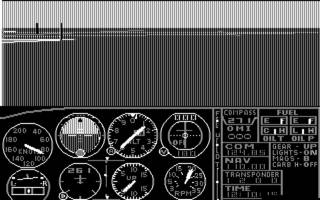
Flight Simulator 2.0
- Released in 1984
In 1984, Microsoft released their version 2 for IBM PCs. This version didn't differ too much from MSFS1; the graphics were somewhat improved, an additional aircraft in the form of the Gates Learjet 25, as well as a more precise simulation in general had been created. The new simulator expanded the scenery coverage to include a model of the entire United States, although the airports were limited to the same areas as in MSFS1.
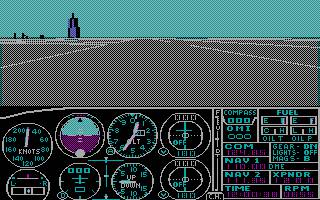
Flight Simulator 3.0
- Released in mid 1988
Microsoft Flight Simulator 3 improved the flight experience by adding additional aircraft and airports to the simulated area found in MSFS2, as well as improved high-res (EGA) graphics, and other features lifted from the Amiga/ST versions.
The four simulated aircraft were the Gates Learjet 25, the Cessna Skylane, the Sopwith Camel and a Schweizer glider. Flight Simulator 3 also allowed the user to customize the display; multiple windows, each displaying one of several views, could be positioned and sized on the screen. The supported views included the instrument and control panel, a map view, and various external camera angles.
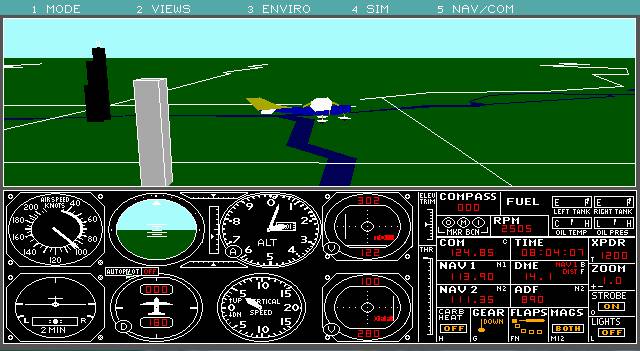
Flight Simulator 4.0
- Released in late 1989
Version 4 followed in 1989, and brought several improvements over MSFS3. These included amongst others; improved aircraft models, as well as an upgraded model of the Cessna Skylane, programmable dynamic scenery (non-interactive air and ground traffic on and near airports moving along static prerecorded paths). The basic version of FS4 was available also for the Macintosh.
A large series on add-on products were produced for FS4 between 1989 and 1993. First from Microsoft & the Bruce Artwick Organization (BAO) came the Aircraft and Scenery Designer (ASD) integration module. This allowed FS4 users to quite easily build, on the fly from directly within the program, custom scenery units know as SC1 files which could be used within FS4 and traded with other users (this activity was quite popular in the FS Forum on CompuServe). Also, ASD provided the addition of the Aircraft Designer Module. Again, from directly within the program the user could select one of two basic type aircraft frames (prop or jet) and proceed to parameter customizations ranging over 4 pages of flight envelope details and visual aspects. Finally, ASD provided additional aircraft including a 747 with a custom dash/cockpit (which required running in 640 x 350 resolution).
Next from Mallard Software and BAO came the Sound, Graphics, and Aircraft Upgrade (SGA). This added digital and synth sound capability to FS4 (which previously was only via PC speaker.) Second a variety of high resolution modes became available for specific types of higher end video cards and chipsets, thus supplying running resolutions up to 800 x 600. As with ASD, the SGA upgrade also came with some additional aircraft designed by BAO, including an Ultra-light.
The final addition was known as the Aircraft Adventure Factory (AAF). AAF consisted of two primary components. First, the Aircraft Factory which was a Windows based program allowing custom design aircraft shapes to be used within FS4 utilizing a unique, rather easy to use CAD type interface, supported by various sub menu and listing options. Once the shape was created and colors assigned to the various pieces, it could be tied to an existing saved flight model as was designed in the Aircraft Designer module. The end result was a two file unit, creating a new custom aircraft for FS4. Thousands of aircraft were designed by users using this utility and like scenery files, found their way onto the FS Forum at CompuServe (the Mecca for FS4).
The other Component of AAF was the Adventure module. Using a simple language (similar to BASIC), a user could design and compile a script that could be run from within FS4. Many FS4 parameters could be accessed including such things as aircraft position, airspeed, altitude, aircraft flight characteristics, etc. These could then be used to do things like display messages on the screen, play VOC audio files, and even display 256 color VGA images. The end result was that users could create fun adventures to use and share.
Other Add-On products (most published by Mallard Software) included: The Scenery Enhancement Edition (SEE4) which further enhanced SC1 files and allowed for AF objects to be used as static objects within SEE4. Pilots Power Tools (PPT) which greatly eased the management of the many aircraft and scenery files available. Finally, a variety of new primary scenery areas created by MicroScene. These included: Hawaii (MS-1), Tahiti (MS-2), Grand Canyon (MS-3), and Japan (MS-4). It should also be pointed out that all available scenery files previously produced by subLogic could also be used quite nicely with FS4, including subLogic's final massive USA East and West scenery collections.
With its many options and add-ons, yet still relatively tight "in program" integration and overall ease of use, the FS4 suite of programs presented a type of VR Toolkit for users with a flight simulator slant. While complex in some aspects, FS4 environment building options (including scenery and aircraft design) would provide an unsurpassed access to these activities for average users. An option, which in later versions of FS, was much less available and increasing complex.
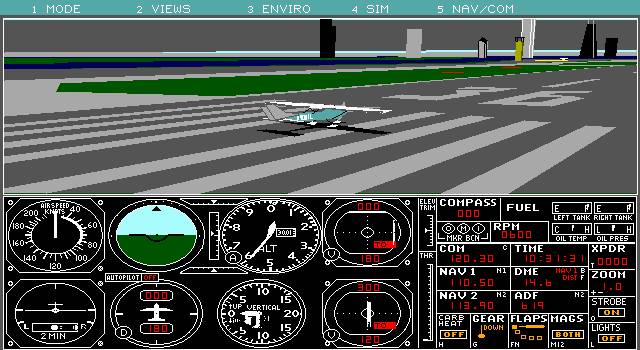
Flight Simulator 5.0
- Released in late 1993
FS5 is the first version of the series to use textures. This allowed FS5 to achieve a much higher degree of realism than the previous flat-shaded simulators. This also made all add-on scenery and aircraft for the previous versions obsolete, as they would look out of place.
The bundled scenery was expanded (now including parts of Europe). Improvements were made to the included aircraft models, the weather system's realism and artificial intelligence. The coordinate system introduced in FS1 was revamped.
More noticeable improvements included the use of digital audio for sound effects, custom cockpits for each aircraft (previous versions had one cockpit that was slightly modified to fit various aircraft), and (of course) better graphics.
It took about a year for add-on developers to get grips with the new engine, but when they did they were not only able to release scenery but also tools like Flightshop that made it feasible for users to design new objects.
Flight Simulator 5.1
- Released in 1995
In 1995, Flight Simulator 5.1 was introduced, adding the ability to handle scenery libraries including wide use of satellite imagery, faster performance and a barrage of weather effects: storms, 3D clouds and fog became true-to-life elements in the Flight Simulator world. This edition was also the first version that was released on CD-ROM.
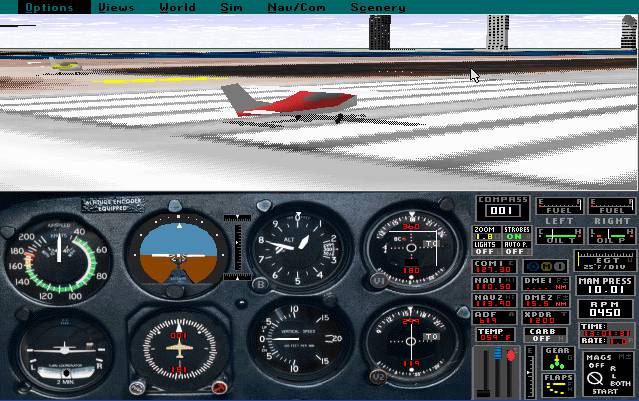
Flight Simulator 95
- Released in mid 1996
As Windows 95 was released, a new version (6.0) was developed for that platform. Although this was more or less just a port from the DOS version (FS5.1), it did feature a vastly improved frame-rate, better haze, and additional aircraft, including the Extra 300 aerobatic aircraft.
This was the first version released after the purchase of BAO by Microsoft, and after having physically relocated development of the BAO development staff to Microsoft's primary campus in Redmond, Washington. The BAO team was integrated with other non-BAO Microsoft staff, such as project management, testing, and artwork.
Additional scenery included major airports outside Europe and the US for the first time.
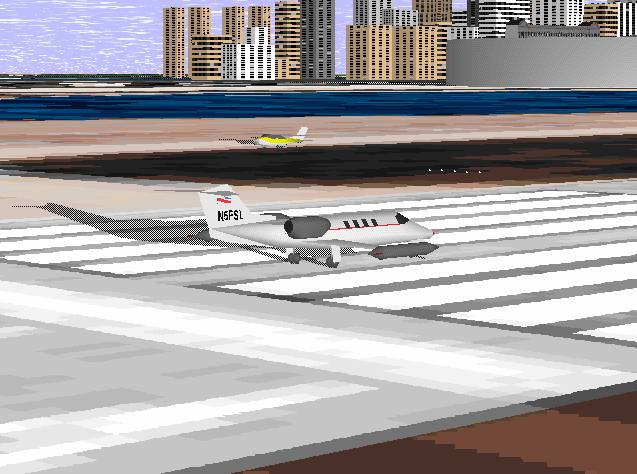
Flight Simulator 98
- Released in mid 1997
FS98 (6.1) is generally regarded as a 'service release', offering minor improvements, with one notable exception: The simulator now also featured a helicopter, as well as a generally improved interface for adding additional aircraft, sceneries, and sounds. Other new 'out of the box' aircraft included a revised Cessna 182 with a photorealistic instrument panel and updated flight model. The primary rationale for updating the 182 was Cessna's return to manufacturing of that model in the late 1990s. The Learjet Model 45 business jet was also included, replacing the aging Lear 35 from earlier versions.
A major expansion of the in-box scenery was also included in this release, including approximately 45 detailed cities (many located outside the United States, some of which were previously included in separate scenery enhancement packs), as well as an increase in the modeled airports to over 3000 worldwide, compared with the approximately 298 in earlier versions. This major increase in scenery production was attributable partially to inclusion of the content from previous standalone scenery packs, as well as new contributions by MicroScene, a company in San Ramon, California who had developed several scenery expansions previously released by Microsoft.
This release also included support for the Microsoft Sidewinder Pro Force Feedback joystick, which allowed the player to receive some sensory input from simulated trim forces on the aircraft controls.
This was the first version to take advantage of 3D-graphic cards, through Microsoft's DirectX technology. With such combination of hardware and software, FS98 not only achieved better performance, but also implemented better haze/visibility effects, "virtual cockpit" views, texture filtering, and sunrise/sunset effects.
Flight Simulator 98
- Released in mid 1997
FS98 (6.1) is generally regarded as a 'service release', offering minor improvements, with one notable exception: The simulator now also featured a helicopter, as well as a generally improved interface for adding additional aircraft, sceneries, and sounds. Other new 'out of the box' aircraft included a revised Cessna 182 with a photorealistic instrument panel and updated flight model. The primary rationale for updating the 182 was Cessna's return to manufacturing of that model in the late 1990s. The Learjet Model 45 business jet was also included, replacing the aging Lear 35 from earlier versions.
A major expansion of the in-box scenery was also included in this release, including approximately 45 detailed cities (many located outside the United States, some of which were previously included in separate scenery enhancement packs), as well as an increase in the modeled airports to over 3000 worldwide, compared with the approximately 298 in earlier versions. This major increase in scenery production was attributable partially to inclusion of the content from previous standalone scenery packs, as well as new contributions by MicroScene, a company in San Ramon, California who had developed several scenery expansions previously released by Microsoft.
This release also included support for the Microsoft Sidewinder Pro Force Feedback joystick, which allowed the player to receive some sensory input from simulated trim forces on the aircraft controls.
This was the first version to take advantage of 3D-graphic cards, through Microsoft's DirectX technology. With such combination of hardware and software, FS98 not only achieved better performance, but also implemented better haze/visibility effects, "virtual cockpit" views, texture filtering, and sunrise/sunset effects.
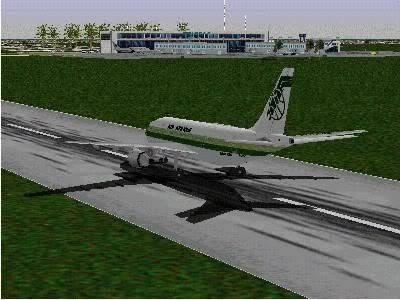
Flight Simulator 2000
- Released in late 1999
FS2000 (7.0) was released as a major improvement over the previous versions, and was also offered in two versions; one version for "normal" users, and one "pro" version with additional aircraft. Although many users had high expectations when this version arrived, many were disappointed when they found out that the simulator demanded high-end hardware; the minimum requirements were only a Pentium 166 MHz computer, although 400–500 MHz computer was deemed necessary to have an even framerate.[2] However, even on a high-end system, stuttering framerate was a problem, especially when performing sharp turns in graphically dense areas.
This version also introduced 3D elevation, making it possible to adjust the elevation for the scenery grids, thus making most of the previous scenery obsolete (as it didn't support this feature). A GPS was also added, enabling an even more realistic operation of the simulator.
New aircraft in FS2000 included the supersonic Aerospatiale-BAC Concorde (prominently featured on both editions' box covers) and the Boeing 777, which had recently entered service at the time.
An often overlooked, but highly significant milestone in Flight Simulator 2000, was the addition of over 17000 new airports, for a total exceeding 20000 worldwide, as well as worldwide navigational aid coverage. This greatly expanded the utility of the product in simulating long international flights as well as instrument-based flight relying on radio navigation aids. Some of these airports, along with additional objects such as radio towers and other "hazard" structures, were built from publicly available U.S. government databases. Others, particularly the larger commercial airports with detailed apron and taxiway structures, were built from detailed information in Jeppesen's proprietary database, one of the primary commercial suppliers of worldwide aviation navigation data.
In combination, these new data sources in Flight Simulator allowed the franchise to claim the inclusion of virtually every documented airport and navigational aid in the world, as well as allowing implementation of the new GPS feature. As was the case with FS98, scenery development using these new data sources in FS2000 was outsourced to MicroScene in San Ramon, working with the core development team at Microsoft.
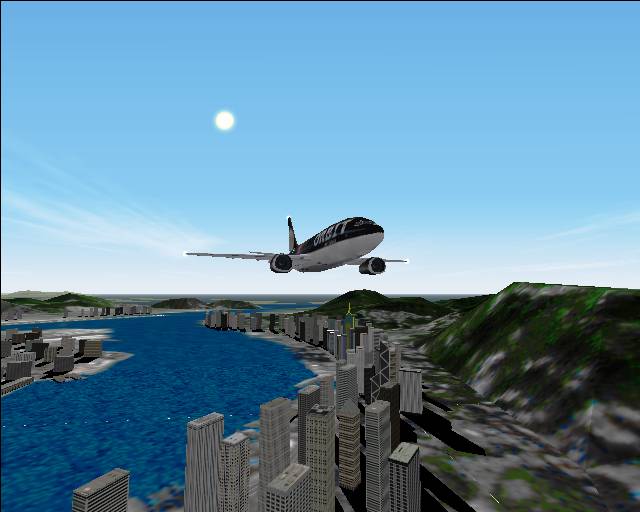
Flight Simulator 2002
- Released in October 2001
FS2002 (8.0) improved vastly over previous versions. In addition to improved graphics, FS2002 introduced ATC and AI aircraft. Users could now fly alongside computer controlled aircraft and communicate with airports. A "target framerate" option was added, enabling a cap on the framerate in order to reduce stuttering while performing texture loading and other "maintenance" tasks. The external view also featured an inertia effect, inducing an illusion of movement in a realistic physical environment. The simulation ran smoother than Flight Simulator 2000, even on comparable hardware. A free copy of Fighter Ace 2 was included with the software.
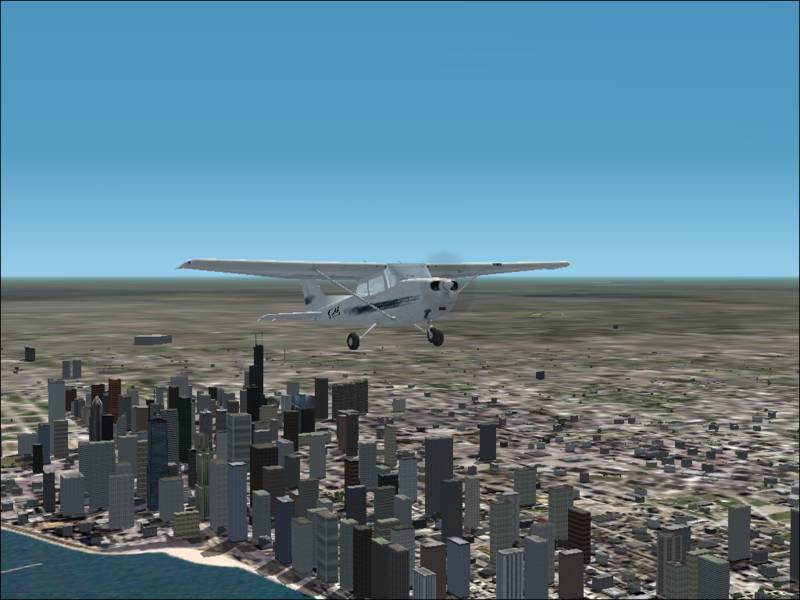
Flight Simulator 2004: A Century of Flight
- Released in July 2003
Flight Simulator 2004: A Century of Flight, also known as FS9, was shipped with many historical aircraft such as the Wright Flyer, Ford Tri-Motor and the Douglas DC-3 to commemorate the 100th anniversary of Wright Brothers' first flight. It included an improved weather engine, which provided true three-dimensional clouds and localized precipitation for the first time. The engine also allowed users to download weather information from real weather stations, allowing the simulator to keep the weather synchronized with the real world.
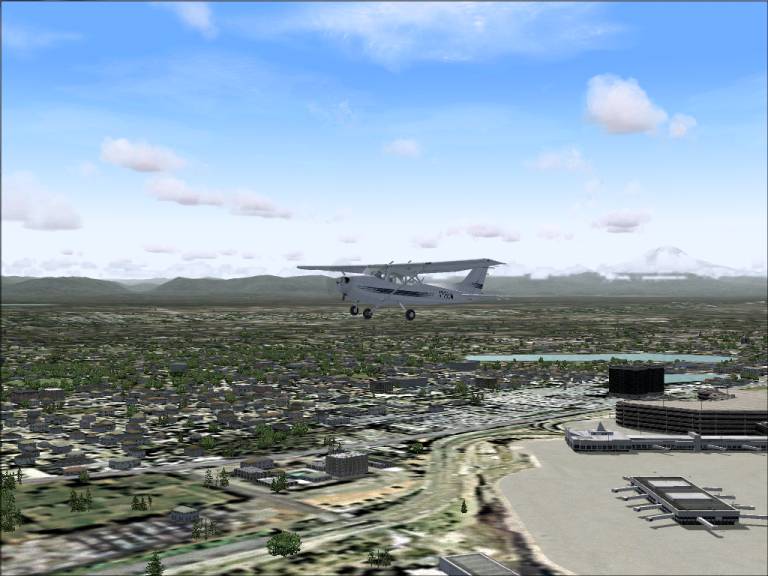
Flight Simulator X
- Released in October 2006
Flight Simulator X, or FSX, is the tenth and current edition of Flight Simulator. The new features include new aircraft, improved multiplayer support, including the ability for two players to fly a single plane, and players to occupy a control tower, and improved scenery with higher resolution ground textures.[3]
It is also the first of the series to be released solely on DVD due to space constraints.

Wikipedia: http://en.wikipedia.org/wiki/History_of_Microsoft_Flight_Simulator#Flight_Simulator_1.0
 Captain
Captain 6 Answers
6 Answers
 Jump to latest
Jump to latest
 Chief Captain
Chief Captain First Officer
First Officer
